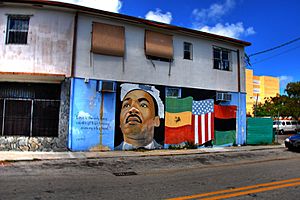Liberty City facts for kids
Quick facts for kids
Liberty City
|
|
|---|---|
|
Neighborhood of Miami
|
|

Liberty City mural
|
|
| Nickname(s):
Model City (historic name)
|
|

The Liberty City neighborhood in Miami
|
|
| Country | |
| State | |
| County | Miami-Dade County |
| City | Miami |
| Elevation | 3 m (10 ft) |
| Population
(2010)
|
|
| • Total | 19,725 |
| • Density | 3,733/km2 (9,669/sq mi) |
| Time zone | UTC-05 (EST) |
| ZIP Code |
33125, 33127, 33142, 33147, 33150
|
| Area code(s) | 305, 786 |
Liberty City is a lively neighborhood in Miami, Florida, United States. It is located in the northern part of Miami. The area is generally bordered by NW 79th Street to the north and NW 54th Street to the south. To the west, you'll find NW 27th Avenue, and to the east, Interstate 95.
Liberty City is known for being home to a large number of African Americans in South Florida. Even though the City of Miami government sometimes calls it "Model City," most local people know it as "Liberty City." The neighborhood is served by the Miami Metrorail system. You can get there using the Dr. Martin Luther King Jr. Plaza and Brownsville stations.
Contents
Discovering Liberty City's Past
Liberty City started as a quiet area on the edge of northern Miami. It really began to grow during the Great Depression in the 1930s.
Building Liberty Square
In 1933, President Franklin D. Roosevelt approved building the Liberty Square housing project. This was a big deal because it was the first project of its kind in the Southern United States. It was built to help people who lived in crowded and run-down areas of Overtown. Construction started in 1934, and the homes opened in 1937.
A Thriving Community Emerges
By the 1940s and 1950s, Liberty City and nearby Brownsville became a successful middle-income African American community. It had many churches, hospitals, and community centers. Famous people lived here, like Kelsey Pharr and M. Athalie Range. M. Athalie Range was the first African American woman elected to the Miami city commission. Even the famous boxer Muhammad Ali lived in the area.
A Place for Everyone
During this time, segregation laws kept African Americans from staying in places like Miami Beach. But places like the Hampton House Motel and Villas welcomed them. Important figures like Rev. Dr. Martin Luther King, Jr. and Althea Gibson stayed there. Even some white celebrities like Mickey Mantle visited.
Changes in the 1960s
The building of Interstate 95 in Overtown brought big changes in the 1960s. Also, segregation laws were ending because of the Civil Rights Act of 1964. Many lower-income families moved to Liberty City after being displaced from Overtown. This led to many middle and higher-income African Americans moving to suburban areas. They moved to places like Florida City and Miami Gardens.
Community Challenges and Resilience
In the 1960s and 1970s, the area faced some challenges. These issues became very clear during community unrest in 1968 and 1980. Despite these difficulties, the community showed great strength.
Liberty City in the Spotlight
In the 1980s, the struggles of inner-city African Americans in Miami gained national attention. The University of Miami's football team won several championships. Many of their star players came from neighborhoods like Liberty City and Overtown. TV shows like Miami Vice also showed the area's conditions to a wider audience.
Music and Sports Stars
Into the 1990s and 2000s, Liberty City's culture shone through its music and sports. Local artists like Luther Campbell of 2 Live Crew helped create the Miami bass music style. This style became very popular in Southern hip hop music. Other talents from the area also became famous. These include rappers Trina and Trick Daddy. Also, NFL players like Chad "Ocho Cinco" Johnson and Willis McGahee came from Liberty City.
Understanding Liberty City's Population
In 2000, Liberty City had a population of 23,009 people. There were 7,772 households in the neighborhood. Most residents, about 94.69%, were Black. About 3.04% were Hispanic or Latino.
The average household had 3.1 people. The average family had 3.7 members. Most people born in Florida lived here, about 74.5% of the population.
Getting Around Liberty City
The Miami Metrorail system helps people travel through the neighborhood. Here are the stations that serve Liberty City:
- Earlington Heights (near Airport Expressway and West 22nd Avenue)
- Brownsville (at North 52nd Street and West 27th Avenue)
- Dr. Martin Luther King Jr. Plaza (at North 62nd Street/Martin Luther King Jr. Blvd and West 27th Avenue)

